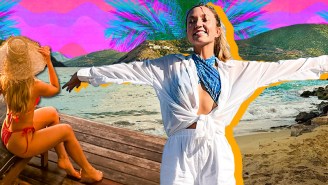Most people I talk to don’t know who the Ese Ejja are. When I first arrived to Peru, I didn’t either. They’re a small group — while 45% of the population of Peru is indigenous, only 800 of them are Ese Ejja. I came in contact with the community while working with the Amazon Conservation Association on women’s empowerment initiatives. Our work wasn’t intended to touch upon issues of water contamination, but those became quickly visible the longer we stuck around.
Ese Ejja means “the real people” in their native language. While they’re traditionally nomadic, the discovery of rubber and the arrival of missionaries in the 19th century led to agricultural reform. The Ese Ejja were forced to accept small parcels of land which divided them into fragmented communities. Gradually, the population was whittled down from an estimated 15,000 at the beginning of the last century.
The community’s spiritual connection with the Amazon is known through history. Some people even say the Esa Ejja came to the world through a thread from the sky, to protect the jungle from invaders and bad spirits. Needless to say, they are hugely interested in Amazonian conservation efforts, as their livelihood depends heavily on a healthy ecosystem, but there’s not much they can do since historically and socially, they are vulnerable themselves.
Over the years, the Ese Ejja have demanded recognition of their traditional lands for hundreds of years, to no avail. Separation from their sacred sites and many of the areas that they relied on for survival only begins to describe the challenges they face. Because they are small, theirs is a story seldom told.
Today, most Ese Ejja reside in the community of Palma Real in the Madre de Dios region of Peru, which happens to be one of the most biodiverse but also most mercury contaminated areas in all of Latin America. A few months ago, I visited the village — arriving after a three-hour boat ride up the Madre de Dios river. While there, I found curious faces and bright eyes but disturbing living conditions.
The eco-system of the Ese Ejja had been wrecked by downriver mining operations — leading to a chronic mercury epidemic that was only recently exposed due to a leaked map of contamination sites. In March of 2016, Peru’s President Ollanta Humala declared a 60-day state of emergency in a large remote area of the Amazon jungle because of extremely high levels of mercury poisoning from illegal gold mining. The country’s environment minister said 41 percent of the population of Madre de Dios is being exposed. It was far from enough, just a quick way for government officials to prove they were interested.
On land, I saw the epidemic with my own eyes — the direct result of years of illegal mining and severe deforestation in the Madre de Dios region. Illegal miners operating in and around Ese Ejja land are polluting the population’s sacred rivers with mercury, used in the gold-extraction process. The metal then enters the food chain via the river water which the Ese Ejja drink and depend on for their survival. They live in direct and constant exposure to mercury. They have no food source due to poisoned fish and no potable water. It’s a precarious situation.
Any change in policies will take take time to reach these remote areas, if they ever do. Meanwhile, restoration of a damaged ecosystem will take significantly longer. The most immediate solution to help protect the Esa Ejja from mercury poisoning is to help filter their drinking water supply. While not all filters are equipped to completely remove metals from the water, some do remove a large percentage of contaminants and diseases. Palma Real — the village I visited — has about 150 homes and not one of them has access to clean drinking water. In one month, with help from Waves for Water, I’ll be returning to the Amazon to implement a water filtration program throughout the entire community and decrease some of the impacts caused by lack of clean water.
Please support us as we work to help this community continue to live close to nature without threats to their livelihood.






